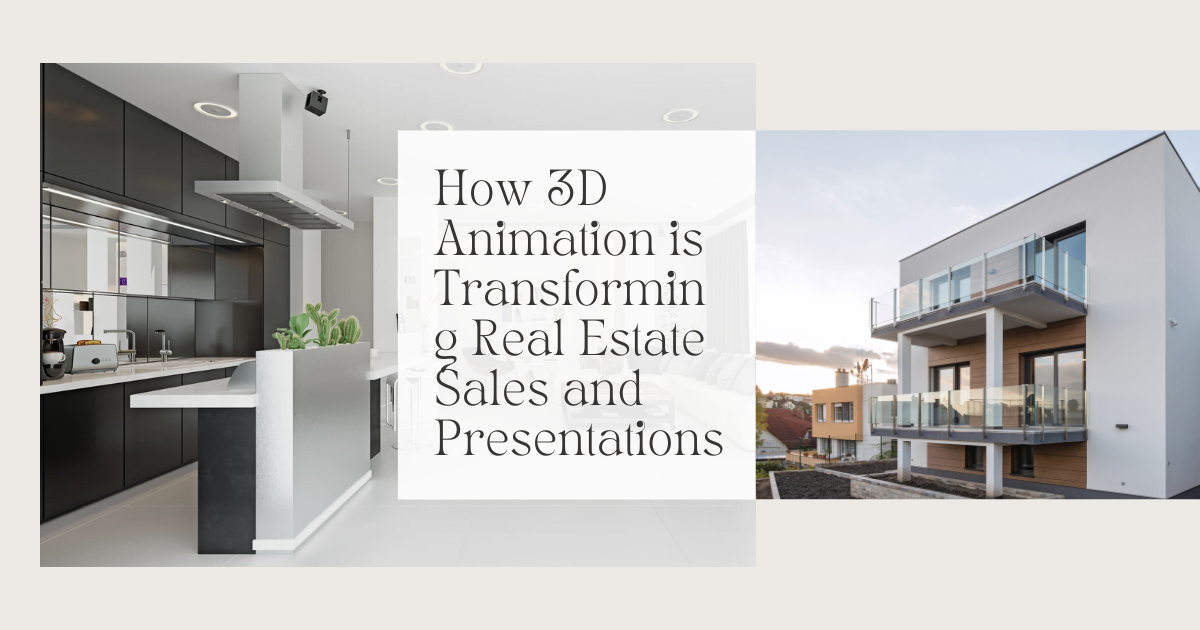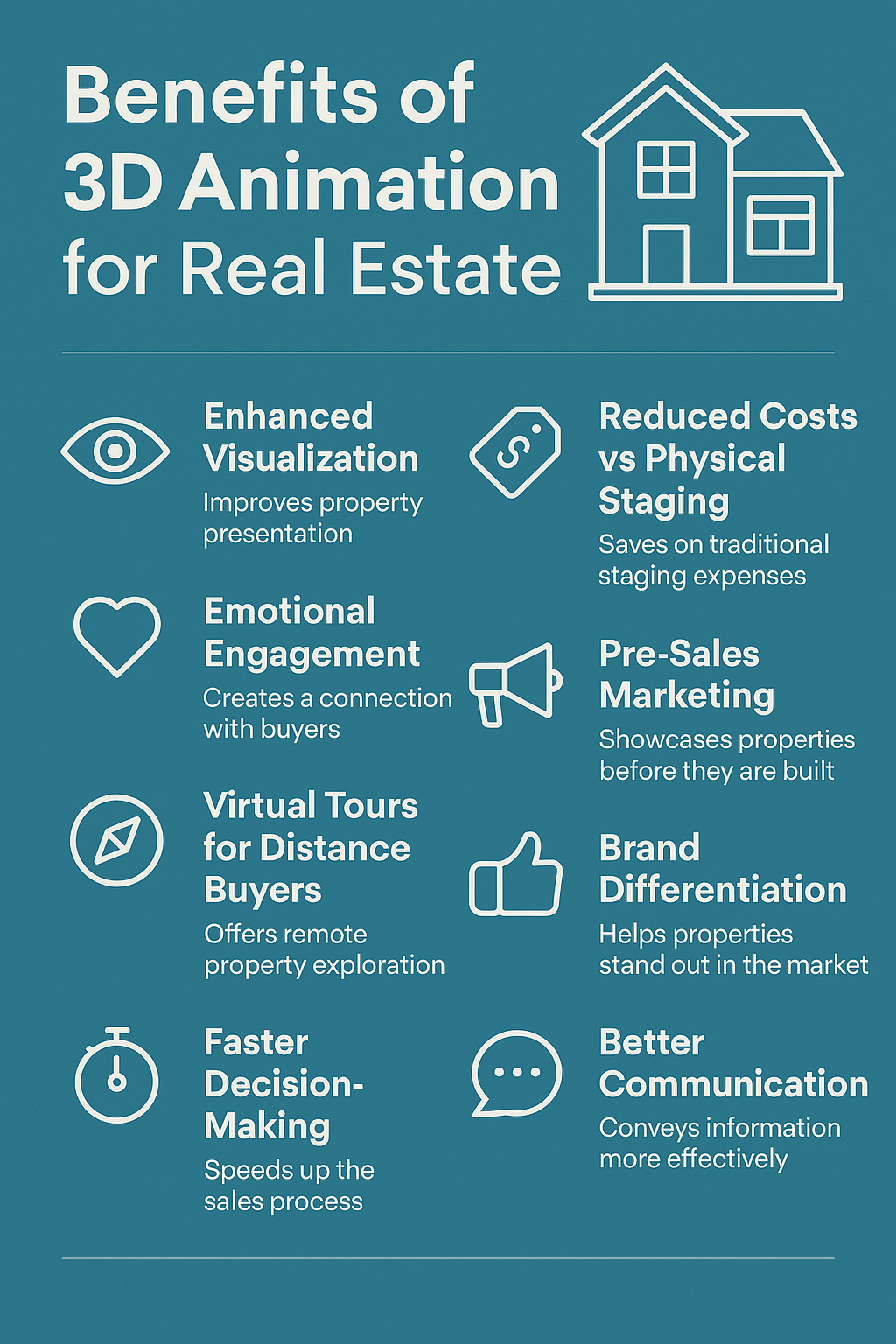Jun 26th, 2025

In today’s highly competitive real estate market, staying ahead requires more than just high-resolution photos and glossy brochures. Real estate developers and marketers are increasingly turning to 3D animation to showcase properties in an engaging, immersive, and effective way. According to industry data, listings that include a 3D animation or virtual tour receive up to 87% more views than those that don’t. With buyers now demanding more transparency, speed, and interaction, 3D animation is becoming a game-changer.
This blog explores how 3D animation is revolutionizing real estate sales and presentations, from enhancing buyer engagement to boosting conversion rates and reducing the sales cycle.
3D animation in real estate refers to the use of computer-generated imagery to simulate real-world properties in a lifelike, interactive manner. It involves:
These tools help buyers visualize the final product, even if it hasn’t been built yet.
📌 Learn more about virtual tours: Wikipedia – Virtual Tour

3D animation allows potential buyers to see beyond static floor plans and renders. They can virtually walk through a home, grasp its dimensions, and understand its layout better.
Animations add music, lighting, and atmosphere, helping buyers emotionally connect with the space.
International or out-of-town buyers can experience the property without physically visiting.
Buyers can make quicker decisions as they understand the space more intuitively.
3D models can replace traditional staging, saving thousands in logistics and design.
Developers can start marketing before laying a brick. This is key for selling off-plan.
Using cutting-edge technology sets developers apart from competitors.
Buyers who aren’t familiar with architectural drawings can easily understand 3D visuals.
Animations can be repurposed for social media, ads, investor presentations, and more.
Animation tools allow for quick tweaks—change wall colors, lighting, or furniture styles.
Animations reduce unscheduled visits, accelerate deals, and bring in higher-quality leads.
In 2024, Miami-based Related Group used Unreal Engine 5 to build lifelike 3D presentations of its waterfront properties. The visuals were so cinematic that they were showcased at architectural events globally.
Firms like Matterport and Kuula offer 360° virtual tours. However, high-end firms are investing in real-time interactive 3D environments powered by tools like Twinmotion and Unreal Engine.
AI-assisted rendering tools like Lumion AI and Enscape now reduce rendering time by 70% while maintaining photorealism.
Instead of miniature models, developers now show full 3D cinematic walkthroughs with background music, sunset lighting, and aerial transitions.
Storytelling techniques—such as showing a family enjoying breakfast or evening skyline views—create deeper buyer engagement.
Buyers from around the world can view properties anytime, without needing a real estate agent to be present.
A professionally produced 60-second 3D animation typically ranges in cost from $2,000 to $20,000, depending on complexity and detail. However, it can reduce time-on-market significantly and generate higher-qualified leads.
While animation is powerful, it should complement—not replace—physical visits and traditional brochures.
Add clickable call-to-action buttons (“Schedule a Visit”) within videos, and track engagement through heatmaps and time-on-page metrics.
Q1: How much does a 3D animation cost for a real estate project?
A basic 60-second animation starts at $2,000. More advanced versions with interactive features can go up to $20,000 or more.
Q2: Can 3D animation fully replace property visits?
Not entirely. While 3D helps in early decision-making, buyers still prefer physical visits before closing.
Q3: Can small real estate agencies benefit from using 3D animation?
Yes, especially with affordable platforms like Lumion and Kuula. It enhances professionalism and trust.
Q4: What tools are best for 3D real estate animation?
Top tools include Unreal Engine, Twinmotion, Blender, Lumion, and SketchUp.
Q5:How can I tell if my 3D animation marketing is effective?
Monitor key performance indicators like how many leads convert, how long visitors stay on the animation page, and how often people leave the page without taking action. These metrics help measure the impact of your animation strategy.
3D animation is no longer a luxury—it’s a necessity in modern real estate sales and presentations. From boosting engagement to shortening sales cycles, it offers measurable advantages across the board. As buyer expectations rise, adopting 3D animation ensures your brand stays ahead of the curve.
Ready to transform your sales presentations? Explore 3D animation today and give your clients the immersive experience they crave.
In today’s highly competitive real estate market, staying ahead requires more than just high-resolution photos and glossy brochures. Real estate developers and marketers are increasingly turning to 3D animation to showcase properties in an engaging, immersive, and effective way. According to industry data, listings that include a 3D animation or virtual tour receive up to […]
Fill out the form below and we will send you a quote today…
Copyright © 2025 Interactivv.com. All rights reserved.